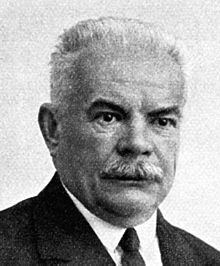Victor Buchs
Victor Buchs (born December 30, 1866 in Estavayer-le-Lac , † March 31, 1953 in Villars-sur-Glâne ) was a Swiss colonial merchant, politician and State Councilor of the canton of Friborg .
Live and act
Victor Buchs was a Roman Catholic and came from the hometowns of Jaun and Muntelier . His parents were Alfred Buchs (1832–1877) and Virginie Hortense Buchs, née Berthoud (1829–1902). The father was a legal agent . In 1897 Victor Buchs married Clara Laura Good from Mels (1864–1947) from St. Gallen . His brother and son, who both had the first name Henri, sat on the Grand Council.
Victor Buchs spent his childhood and youth in Murten . He did a commercial apprenticeship in Lugano (1883), after which he worked in a large bank in Venice and an import-export company in Naples (1885–1889). Thanks to his experience and his language skills, he managed a branch in Mitsiwa (1889–1895) in what was then the Italian colony of Eritrea . Trade trips took him to Abyssinia and British India .
Returning to his home canton in 1895, he and his brother Henri ran the Sainte-Apolline pasta factory in Villars-sur-Glâne . As a versatile entrepreneur, he was also active in the management of the watch factory in Muntelier , a community that made him an honorary citizen . Due to his banking knowledge, he was appointed supervisory commissioner of the state bank in 1917, for which he had worked as a collector since 1913.
Buchs' political career began in 1907 when he was elected to the municipal council of Villars-sur-Glâne . He held this office until his appointment to the State Council on May 27, 1919, when the conservative majority in the Grand Council gave the liberals a seat. As the second representative of this minority in the cantonal government since 1857, a decade after Antoine Weissenbach's resignation in 1909, Buchs was the only free-thinking councilor for 17 years. He headed the building department and was President of the State Council three times (1922, 1928, 1935). Since his name appeared on the joint list of the Liberals and Conservatives, he was re-elected in 1921, 1926 and 1931 with the highest number of votes. In 1936 he resigned at the end of a legislature. Despite his brilliant appearance and his commitment, he could not play a prominent role in the State Council as a representative of the minority.
His election to the State Council fell at a time that was marked by the economic problems associated with the end of the First World War and the crisis of the early 1930s, without the canton having been able to regain its strength in the 1920s. In this environment he concentrated on the one hand to modernize and develop the infrastructures, on the other hand to secure jobs and support the economy. In a difficult exercise in balancing the state finances, Buchs carried out major construction projects such as the Pérolles Bridge (1922), the Zähringer Bridge (1924), the Corbières Bridge (1927) and the concreting of the Grandfey Bridge (1927). In 1931 he also launched a major renovation (taring) program for the most important road connections. At the same time he worked out a road law (1923), which adapted the legislation to the increased motorized traffic.
The work carried out under his direction also included the construction or renovation of numerous public buildings, including the armories of Freiburg and Bulle , the new Freiburg train station and the new buildings of the technical center and the Agricultural Institute Grangeneuve. His ambitious program to renovate the Church of St. Nicholas could not be completed due to a lack of finances. In terms of power supply, he continued the policy of his predecessors, supervised the construction of the Montsalvens dam and took up the dossier of the Rossens dam again. He had the work of his departments documented with numerous photographs.
As construction director, he took over tasks from his predecessors on numerous boards of directors, some of which he continued and decisively shaped after his resignation. He was President of FEW (1919–1936), Vice President of the FEW Administrative Board (1936–1950) and member of the Board of Directors. As a member, Vice-President and Honorary Chairman of the Board of Directors of Energie Ouest Suisse (EOS), he was involved in the Dixence and Grande Dixence projects. He also sat on the boards of numerous railway companies in western Switzerland (Chemins de fer électriques de la Gruyère, Freiburg – Murten – Ins, GFM , MOB and former SBB district council). With Bernard Weck he was one of the creators of the successful merger of CEG, FMI and BR, from which the GFM emerged in 1942.
A friend of history, he wrote several works, in particular on the Freiburg railways and bridges, the Les Faverges winery and the community of Villars-sur-Glâne. After many years of participation in the parish council, he took over its presidium (1945–1953). Until his death, he also presided over the St. Joseph Institute for the Deaf and Mute. He died on March 31, 1953 at the age of 86. He was buried in a family grave in the Villars-sur-Glâne cemetery.
literature
- Michel Carrière: Buchs, Victor. In: Historical Lexicon of Switzerland .
- Georges Andrey , John Clerc, Jean-Pierre Dorand et Nicolas Gex: The Freiburg Council of State: 1848–2011. History, organization, members . Editions La Sarine, Freiburg 2012, ISBN 978-2-88355-153-4 .
Web links
- Publications by and about Victor Buchs in the Helveticat catalog of the Swiss National Library
Individual evidence
- ↑ Robert Savary: Victor Buchs. In: Find a Grave . May 29, 2016, accessed May 1, 2019 .
| personal data | |
|---|---|
| SURNAME | Buchs, Victor |
| BRIEF DESCRIPTION | Swiss politician and State Councilor for the Canton of Friborg |
| DATE OF BIRTH | December 30, 1866 |
| PLACE OF BIRTH | Estavayer-le-Lac |
| DATE OF DEATH | March 31, 1953 |
| Place of death | Villars-sur-Glâne |
